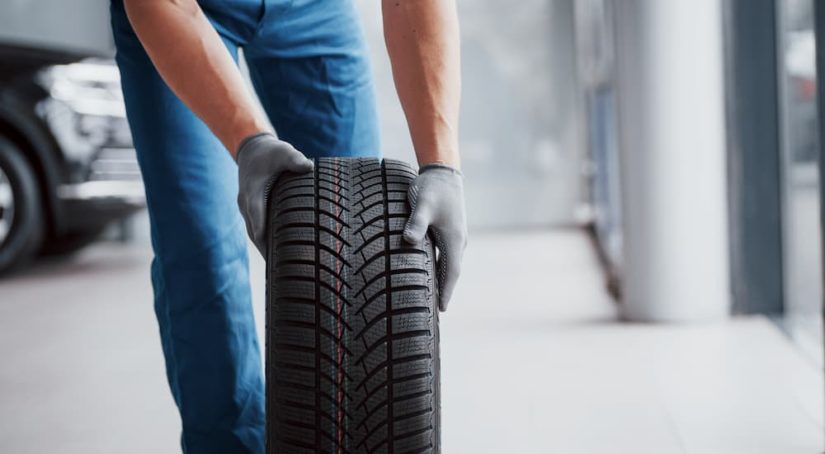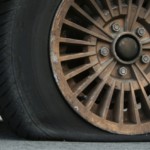There are few things more exciting than the feeling that comes with buying a new car. You can’t wait to get behind the wheel, hear the sound of the engine turning over, and throw your favorite tunes on the radio. While these emotions are natural to have after the purchasing process has concluded, there’s one factor you might be overlooking—the tires. Sure, your car has that new car smell that’s intoxicating, but what about those four pieces of rubber that your vehicle is currently resting on? How long is it going to be before you need to visit a tire center? Today, we’re going to find out by answering the common questions that consumers and car buyers have.
Should I Keep the Tires My New Vehicle Came With?
When you went to the dealership and took your new vehicle for that first test drive, you might have had some apprehension regarding the ride. A veteran car buyer knows to pay close attention to how well the vehicle handles and what noises it is making. There’s a reason for that. Manufacturers and dealers understand that ride quality and road noise are things that many people pay attention to, and it all starts with the tires.
More often than not, the tires on any new vehicle at a dealership are of decent quality. Why is this so? Vehicles that are marked for sale most likely have many customers coming in to take them for test drives. The tires that are on your vehicle when you first purchase it are specifically chosen by the manufacturer to meet the level of performance that the vehicle is designed for. Case in point––a vehicle with four-wheel drive will probably come with tires that can travel on and off the pavement with minimal difficulty. A vehicle built for the average family will most likely come with all-season tires optimized for safe driving.
Because manufacturers put considerable effort into matching tires to vehicles, it’s advised that when it comes time to have your tires replaced, you rely on the same brand and type that was on your vehicle when you first purchased it. If you choose to use something different, make sure to consult with your tire center experts so that the new tires work properly with your car, truck, or SUV.

When Should I Have the Tires Replaced?
Believe us when we say there is no definitive answer to this question. There are a number of determining factors that make replacing your tires necessary, and we’ll now explore each one in hopes of giving you a better idea. However, the first thing we need to stress about getting any new tires is this––all four need to be replaced at the same time.
Let’s turn to shoes for a brief moment. If you get a hole in one shoe, do you just replace that one, or do you get a new pair? Well, your tires operate similarly. When you bring in your vehicle for an oil change, the technician will usually rotate your tires, and there’s a reason for this. The tread on your tires needs to wear evenly. If there’s too much wear on just one or two of your tires, you will have to replace tires that still have life in them. Rotating them spreads the wear out evenly.
The tread depth is the main factor determining when new tires are needed. The good news is that there’s a quick way to test this on your own that will inform you of your tires’ tread depth. Take a penny, and place it into your tire tread, head down. If your tread conceals Lincoln’s head completely, you’re in a good place with your tread depth. However, if you can see Lincoln as clear as day, your tread has worn down considerably, and it’s time to get your tires replaced.
Two elements that make a considerable difference in how often you need to have your tires replaced are how often you drive and where you live. According to the NHTSA (National Highway Traffic Safety Association), a set of tires should normally be replaced every six years or 50,000 miles. However, you must take into consideration how often you drive, your habits behind the wheel, and the terrain you navigate. If you constantly commute over bumpy roads that aren’t maintained well, you might need to replace your tires sooner rather than later.
On the Street Where You Live
As we alluded to earlier, the area where you live has a considerable impact on the expected life of your tires. It can also help you choose what to get when it comes time to replace the tires your vehicle came with when you bought it.
If you live in an area that has favorable weather all year long, you can make do with a set of all-season tires. These are great for navigating through warm and cold weather as long as the temperature doesn’t drop below freezing. As their name suggests, many drivers utilize these tires all year round as they’re cost-effective and don’t need to be replaced for a considerable amount of time. While all-season tires are great for light winter conditions, those who live in a much colder climate will need something more effective when the weather changes.
If you live in a climate that experiences heavy snowfall and below-freezing temperatures during the winter months, you should consider investing in a pair of winter tires, sometimes referred to as snow tires. These are specifically designed to combat the slippery conditions that accompany heavy snow and freezing temperatures. Winter tires have a different tread pattern that allows them to keep snow and ice from accumulating and can help you maintain traction while in unfavorable road conditions.
Winter tires aren’t meant for usage all year long. Most drivers have them installed when the temperature starts to drop around freezing and replace them with all-season tires when the weather returns to a normal state. While having two sets of individual tires might seem like a lot to be concerned about, this has a distinct advantage. Because you’re only using your winter tires for four months of the year, you’re not putting excess wear and tear on your all-season tires at this time. Both sets will end up lasting much longer because of this.
If you live in a colder climate and opt for a pair of winter tires, it’s important that you store them properly when they’re not in use. This means making sure they’re properly cleaned once they’re removed and storing them in an area that remains at roughly the same temperature all year long.

A Final Thought on Your Four Wheels
When you drive your vehicle home for the first time, it’s important to take a few minutes and reflect upon how much wear and tear it’s going to sustain over time and the importance of routine maintenance at regular intervals. Your tires are one of the most important parts of your vehicle’s longevity. Getting them rotated each time you get an oil change will ensure that the tread wears evenly, and regular alignments will help prevent excessive wear. If you’re unsure of what tire brand will be best, ask your tire center which brands are the most trusted and advantageous. When in doubt, simply use the same type of tire that your new car came with. The manufacturer usually knows best.



